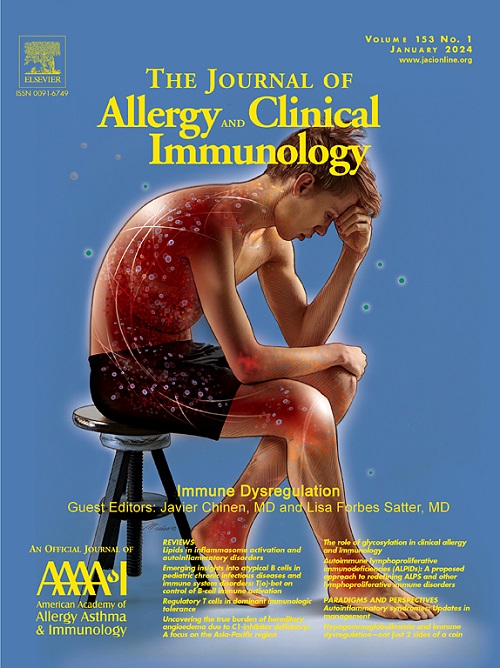The nasal microbiome in early infancy is primarily shaped by the maternal nasal microbiome
IF 11.2
1区 医学
Q1 ALLERGY
引用次数: 0
Abstract
Background
The infant nasal microbiota closely mediates the risks of developing childhood respiratory diseases. However, the primary sources of these early residing bacteria remain largely unknown, preventing the development of microbiome strategies for disease prevention.
Objective
Our aim was to identify the primary maternal source of bacteria found in the early infant nasal microbiome.
Methods
We conducted a birth cohort study titled the Mother Infant Microbiome International Cohort (MIMIC) study. We recruited 95 mother-newborn dyads from 3 sites (St Louis, Mo; San Juan, Puerto Rico; and Accra, Ghana) and collected samples at 2 time points (at the infants’ birth and when they were around 2 months old). We performed analyses of 16S ribosomal RNA gene sequencing data to evaluate the maternal microbiomes (nasal, saliva, breast milk, and areola skin) as sources seeding the infant nasal microbiome.
Results
The infant nasal microbiome underwent a major compositional change during the first 2 months of life. The maternal nasal microbiome was identified as the primary source of bacteria in the early nasal microbiome across the 3 study regions. Corynebacterium was predominantly transferred from the maternal nasal microbiome. Infants were more likely to harbor a Corynebacterium-dominant nasal microbiome if the nasal microbiome of their mother was Corynebacterium dominant.
Conclusions
The maternal nasal microbiome is an important source of bacteria in the early nasal microbiome. A large portion of transmitted bacteria from the maternal nasal microbiome belonged to the generally beneficial bacterial genus Corynebacterium. The results from this study will aid in the development of early-life intervention strategies aimed at reducing the incidence of childhood respiratory diseases and asthma.

婴儿早期的鼻腔微生物群主要由母体的鼻腔微生物群形成。
背景:婴儿鼻腔微生物群与儿童呼吸道疾病的发病风险密切相关。然而,这些早期驻留细菌的主要来源在很大程度上仍然未知,这阻碍了微生物组预防疾病策略的发展。目的确定早期婴儿鼻腔微生物群的主要母系细菌来源。方法我们进行了一项出生队列研究,命名为母婴微生物组国际队列(MIMIC)。我们从三个地点(美国密苏里州圣路易斯市;波多黎各圣胡安;和加纳阿克拉),并在两个时间点(出生时和大约两个月大时)采集样本。我们对16S核糖体RNA基因测序数据进行了分析,以评估母体微生物组(鼻腔、唾液、母乳和乳晕皮肤)作为婴儿鼻腔微生物组的来源。结果婴儿鼻微生物组在出生后的前两个月发生了重大的组成变化。在这三个地区,母亲的鼻腔微生物组被确定为早期鼻腔微生物组的主要细菌来源。棒状杆菌主要来自母体的鼻腔微生物群。如果婴儿的母亲的鼻腔微生物群是棒状杆菌为主,婴儿更有可能携带棒状杆菌为主的鼻腔微生物群。结论母亲鼻腔微生物群是早期鼻腔微生物群的重要细菌来源。大部分来自母体鼻腔微生物群的传播细菌是一种通常有益的细菌属,棒状杆菌。这项研究的结果将有助于制定旨在减少儿童呼吸系统疾病和哮喘发病率的早期生活干预策略。
本文章由计算机程序翻译,如有差异,请以英文原文为准。
求助全文
约1分钟内获得全文
求助全文
来源期刊
CiteScore
25.90
自引率
7.70%
发文量
1302
审稿时长
38 days
期刊介绍:
The Journal of Allergy and Clinical Immunology is a prestigious publication that features groundbreaking research in the fields of Allergy, Asthma, and Immunology. This influential journal publishes high-impact research papers that explore various topics, including asthma, food allergy, allergic rhinitis, atopic dermatitis, primary immune deficiencies, occupational and environmental allergy, and other allergic and immunologic diseases. The articles not only report on clinical trials and mechanistic studies but also provide insights into novel therapies, underlying mechanisms, and important discoveries that contribute to our understanding of these diseases. By sharing this valuable information, the journal aims to enhance the diagnosis and management of patients in the future.

 求助内容:
求助内容: 应助结果提醒方式:
应助结果提醒方式:


